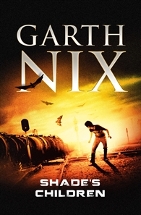Shade's children by Garth Nix

Allen and Unwin, 2012 (1997). ISBN 9781 74237 977 7.
(Ages: 12+) Highly recommended. Dystopian. Adventure. This
richly detailed story, plunges the reader head first into a
dystopian world where children are harvested at 14, the Sad
Birthday, for their brains and flesh used to build machines capable
of hunting down any opposition. Gold-Eye has escaped from the Dorm,
imagining up a razor blade from pictures on the newspapers he found
in the walls, cutting out the tracking device in his wrist, then
running for his life. He is about to be taken by the Trackers, when
someone suddenly appears and kills the monster, winching him to
safety, but their escape is not complete just yet. He meets three
other humans like himself, and struggles to communicate with words
he has not spoken for years.
The menacing Overlords with their retinue of machine made but flesh
enhanced cohorts of Myrmidons, Trackers, Ferrets and Wingers, shadow
the four as they try to escape. The scene is set for an adventure
like no other as the reader, along with Gold-Eye must piece together
the sparse information to find out where he is and who he can trust.
In meeting Shade, the hologram which directs the others who have
saved him, Gold-Eye is reticent to put his trust in him. But
survival in this hostile future is paramount, and so he joins the
group.
Reading this again was absolutely thrilling. I could recall over
arching ideas, but the detail had escaped me, so reading it
recharged my earlier impressions of its inventive components and
stunning originality. It was one of the first YA books to promote a
dystopian future, where readers are asked to project their society
into the next generation, seeing possible and fantastic end results
to the society in which we live.
Dystopian books are now common, stories in which children's bodies
are used, a more familiar idea, but this book, first published in
1997, expressed daring, fresh new ideas. This novel which broke new
ground was adventurous and astonishing, and that astonishment for
the reader, whether old or new, is still there in bucket loads.
Fran Knight